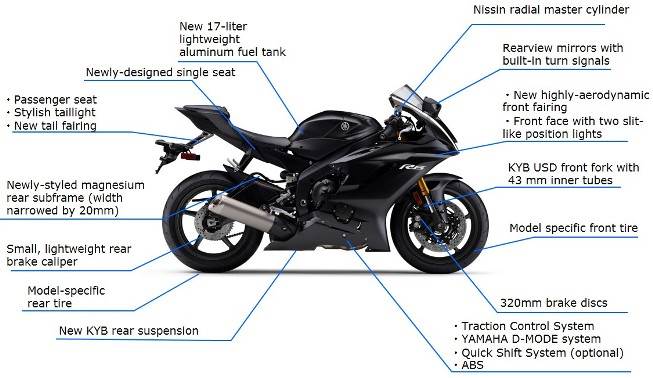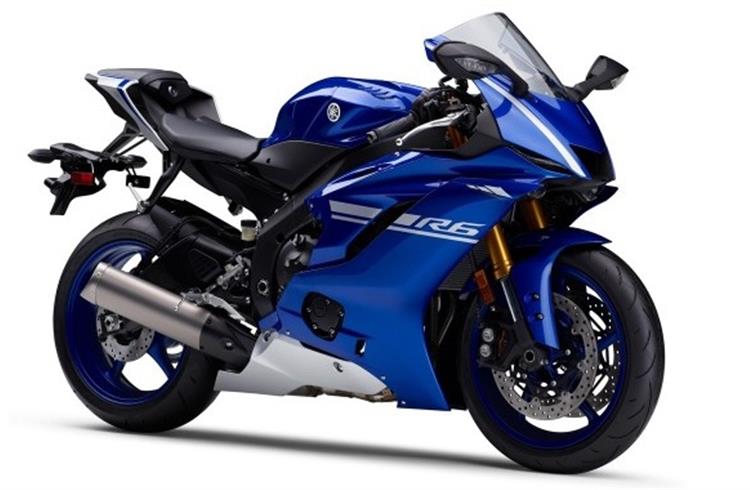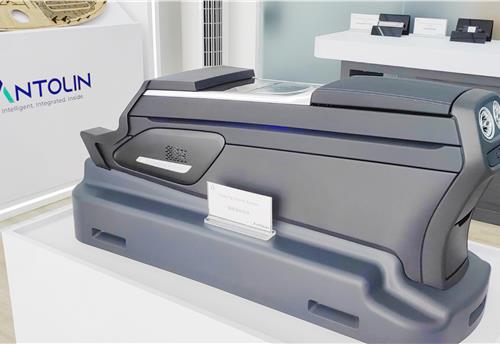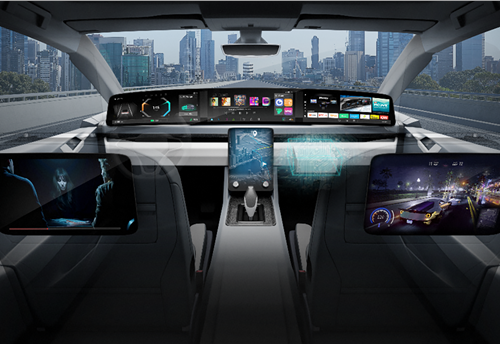Yamaha reveals 2017 YZF-R6
Yamaha says that along with proven features of excellence in circuit performance and exemplary performance on winding roads, this new model takes riding performance to the next level and embraces the R-series styling.
Yamaha Motor Co has announced today the March 2017 North American launch of the 599cc Supersport YZF-R6, the first major model change in nine years. The world première of this new model was held on October 13 at the AIM Expo (American International Motorcycle Expo) in Florida, USA.
Yamaha says that along with proven features of excellence in circuit performance and exemplary performance on winding roads, this new model takes riding performance to the next level and embraces the R-series styling.
The new model YZF-R6 now includes ABS and TCS (Traction Control System), which allows the bike to utilize drive from the rear wheel more efficiently during acceleration, high performance suspension and brake parts, a lightweight aluminium fuel tank, and a new, slim CF magnesium die-cast rear subframe.
‘Next-generation R-DNA’ is expressed through a design in which the vehicle body works in harmony with airflow. Even higher sports performance is achieved through incorporating vehicle body parts and control technology created during the development of the YZF-R1, and ensuring thorough overall balance.
Key highlights

Traction Control System: Adoption of the TCS (Traction Control System) provides a means for extracting more efficient drive force from the rear tire during acceleration. If signs of rear wheelspin are detected during takeoff, smoother acceleration and handling are supported by the integrated control of ignition timing, fuel injection volume, and throttle valve opening. There are six selectable levels of intervention depending on the riding environment, tyre grippiness, and rider preference.
Incorporation of same parts as on the YZF-R1, such as front forks: Upside-down suspension has been adopted with a 43mm diameter inner tube replacing the current 41mm front forks. The front fork is the same type as the one on the YZF-R1 and uses specific settings to provide good damping force and a planted feel from the front.
The same type of parts as on the YZF-R1 have also been utilised in the front brakes. The disc has a 320mm diameter and the aluminium 4-pot opposed-piston monobloc calipers (2-pad type) are paired to a Nissin radial master cylinder (current disc is 310mm diameter).
Aluminium fuel tank defined by advanced manufacturing technology: Continuing from the YZF-R1, a lightweight aluminium fuel tank (17ℓ) has been adopted. Its shape has deep knee pockets to suit quick movements from the rider. Compared to a steel fuel tank, it provides weight savings of approx. 1.2 kg (vs. the current YZF-R6). Although bending and shaping aluminium to create a fuel tank with complicated contours such as these knee pockets proved to be a challenge as aluminum’s characteristics as a metal make this difficult to achieve, post press CMT (cold metal transfer) welding technology has been used with this model and highly-skilled craftsmen complete the welds and finish by hand, resulting in strong, tightly-sealed welds and a beautiful exterior appearance.
New seat and slim rear subframe to support the rider’s actions: The seat and rear sub-frame have been newly designed. The top surface of the seat has a gentler upward slant, while the portion around the rider’s thighs has more freedom for a good feeling of fit and leg reach to the ground. In conjunction with the benefits of the new tank, the improved seating position provides for an enhanced level of agile maneuverability. The magnesium rear sub-frame supporting the seat maintains the strength and rigidity of the current model while being approximately 20mm narrower in width.
Aerodynamic new front fairing design: The adoption of a newly-designed front fairing and windscreen provide an 8% improvement in aerodynamic efficiency (less drag) over the current model. This contributes to a higher top speed during track riding.
New futuristic styling: The key styling phrases for this model have been to convey the next generation of R-DNA, a futuristic look and feel that is strong, striking, and sentient, and pure entertainment, be it on the track or on the street. Features like the newly-shaped LED position lights give the front face a glaring appearance.
Quick Shift System (QSS) for smooth upshifts: A Quick Shift System (QSS) is now optionally available to help provide fast, smooth upshifts. When the switch positioned on the shift lever rod detects motion at thegearshifter pedal, it adjusts engine output according to ECU calculations and instantly cancels out the drive torque of the engaged gear to promote a swifter shifting of gears. It is the same mechanism used on the current YZF-R1.

RELATED ARTICLES
Antolin unveils sustainable tech solutions at Beijing Motor Show
In line with its China market roadmap, Antolin is showcasing its latest advances in lighting, HMI, electronics, and sust...
Visteon wins $1.4 billion in new business in Q1 2024, launches 26 new products
Digitisation of vehicle cockpit megatrend is a key growth driver for Visteon with over $400 million of displays wins; Vi...
BMW uses Catena-X ecosystem using real-world CO2 data to enhance quality
Working together with partners and suppliers, the company has modelled a complete data chain for the first time using re...





 By Autocar Pro News Desk
By Autocar Pro News Desk
 14 Oct 2016
14 Oct 2016
 9174 Views
9174 Views









